Cayman sees driest year on record
(CNS): With just half of the annual rainfall that would normally be expected in any given twelve-month period, 2016 in the Cayman Islands is in the record books. Less than 28 inches of rain was measured at the weather station at Owen Roberts International Airport over the last year, when on average the island could expect to enjoy more than 56 inches. Officials from the National Weather Service confirmed Monday that 2016 was a very dry year. But with just 27.98 inches, it was the driest year since records began in the 1950’s.
2016 was not only the driest year, it came very close to being the hottest as well. The average temperature for 2016 was 83.1°F, or 1.3°F above the 30-year average of 81.8°F. The all-time record was in 2002/2003, when the average temperatures was recorded at is 83.2°F.
However, local weather experts point out that the trend for temperatures is up as shown by the graphs.
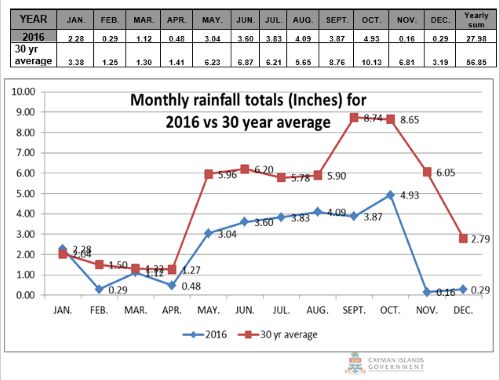 The hot dry weather was a feature throughout the year, and while the first few months are generally much drier, last May, the usual start of the rainy season, saw just two real rainy days producing less than two inches of rainfall. By the end of the month only 3.04 inches had fallen, far below the average amount for the month of almost six inches.
The hot dry weather was a feature throughout the year, and while the first few months are generally much drier, last May, the usual start of the rainy season, saw just two real rainy days producing less than two inches of rainfall. By the end of the month only 3.04 inches had fallen, far below the average amount for the month of almost six inches.
The dry, hot weather continued throughout the summer wet season, leaving high monthly rain deficits, the National Weather Service said, most notably in September through until November, when 14.5 inches less rain fell during that period than the average expectations.
Whether the increasing drought and rising temperature pattern in Cayman is specifically related to global climate change will, of course, be up for debate but the reality of climate change, which is accepted by 97% of the scientific community, would suggest it is likely.
All around the world temperatures were breaking records and 2016 was confirmed last week as the hottest year on record for the Earth, beating 2015 by a significant margin. Global surface temperatures in averaged 14.8℃ or 1.3℃ higher than estimated before the Industrial Revolution, when the use by humans of fossil fuels began in earnest.
See full details of this year’s weather activity in the CNS library
Category: Science & Nature, Weather





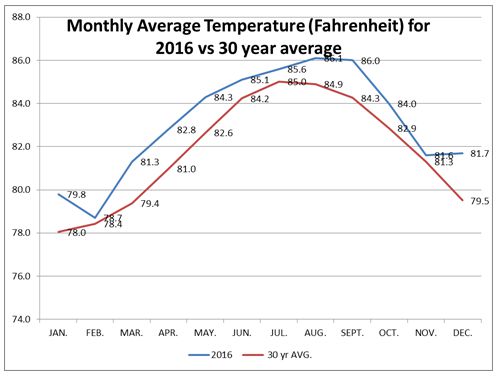












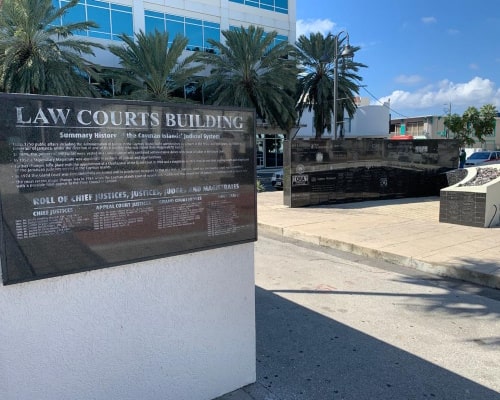



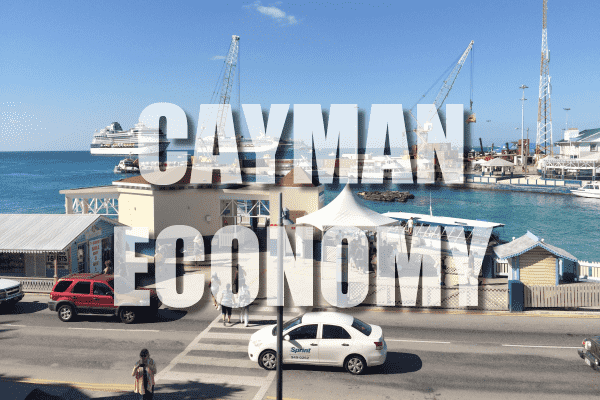









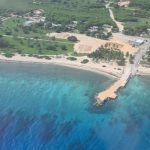




El Nino ending affects the Caribbean.
Wondered why the bars were so busy.
its dry dry dry……and for anyone that pays attention to it…..it was obvious.
it should have been raining well into November and it stopped at the beginning of it.
I think the bigger question should be what are the averages over the last 10 years or so….I think you would find our rainfall amounts are steadily declining year on year which is a sign that our region is becoming more arid which given our lack of fresh water is very concerning. I have no doubt that by the middle of this year the water lenses of Grand Cayman will be very saline and its a matter of time before water rates go up. The more saline the water the harder it is to make it fresher….or more expensive.
The desalination plant does not process water from the freshwater lens. It uses seawater that is extracted from deep wells.
I am aware of that but arent those wells brackish not salt?….my understanding is that the lenses feeds those wells
Anyone that pays attention to the weather will know that the island was simply unlucky last year. Every tropical system that approached the island rained out before passing us then re-built on the other side of the island and continued raining after passing us. Don’t believe me? Just think back to all of the “rain this weekend” forecasts which never came true.
Damn those Chinese!
Meanwhile… http://www.climatedepot.com/2017/01/10/pravda-scientists-now-warn-of-a-new-ice-age-as-temperature-plummets-to-80f-in-russia/
This is only the figures for Cayman – imagine what the rest of the figures globally are looking like.
You do not have to be a scientist to have the common sense to understand what extended periods of hot and dry weather produce.
Less crops, food shortages, the earth itself holding enormous amounts of heat which then brings with it all kinds of natural disasters. If the previous record year of hot and dry weather was 2003 (Hurricane Ivan came along in 2004) then we can only wait to see what this hurricane season will bring.
I have not been able to find any recent information on the condition of the ozone layer, but this is the earth’s natural heat barrier. If it was deteriorating in the 70s; can you imagine what stage of deterioration it is at now?
Ok, well apparently scientists came out last year and said the ozone hole is ‘healing’.
But the current natural happenings in the world are eerily similar to what they have explained in the same article would happen with the deterioration of the ozone:
“The ozone layer, a fragile shield of gas, protects animal and plant life on Earth from powerful UV rays. When the ozone layer is weakened, more UV rays can get through and affect humans, making them prone to skin cancer, cataracts and other diseases. There also may be consequences for plant life, including lower crop yields and disruptions in the ocean’s food chain.”
http://edition.cnn.com/2016/07/01/health/antarctic-ozone-layer-healing/
Run for your lives. The climate has arrived.
Everybody just keep calm, it isn’t getting any hotter, the Earth is flat, climate change is a hoax and Jesus will be back soon to save us all after he gets through with his busy schedule.
the only climate related question for cayman: how much are sea levels rising?
how come nobody can provide an answer?
Well, judging by the area in East End we used to go swimming at in 2015; sea levels have risen a lot in the past 18 mths alone. We can no longer walk out to the little spot anymore because the shore/path is gone.
Not to mention the shoreline in South Sound that looks like it will soon be at the roadside.
Your so full of it My cabana in east end is exactly where it was 15 years ago Hell is located in Kayman so lack of rain should be normal just saying ////
Not sure what part of East End your cabana is located, farm road maybe?
Heads buried firmly in the sand, no one wants to know. Careful, this might fall foul on the real estate market. L&S have some data though but its probably not enough to show a solid trend. The mind boggles why Cayman hasn’t yet got its own reference tidal station like some other lesser off Caribbean Islands.
All those tree huggers and lying scientists talked so much nonsense that it became true. Drain the swamp!
The end is nigh.
For you it is.
For the rest of us it might still take a few million years before the sun runs out of fuel.
5 Billion years approx. Which by then the Sun will engulf the solar system as it changes from main sequence to a super red giant. Millions of years from now the Sun will still have hyrdogen to produce fusion.
I wonder if I will have got my Cayman pension by then?
Many other things on the horizon(pun) before the sun runs out of fuel. Like that swamp drainer up north.